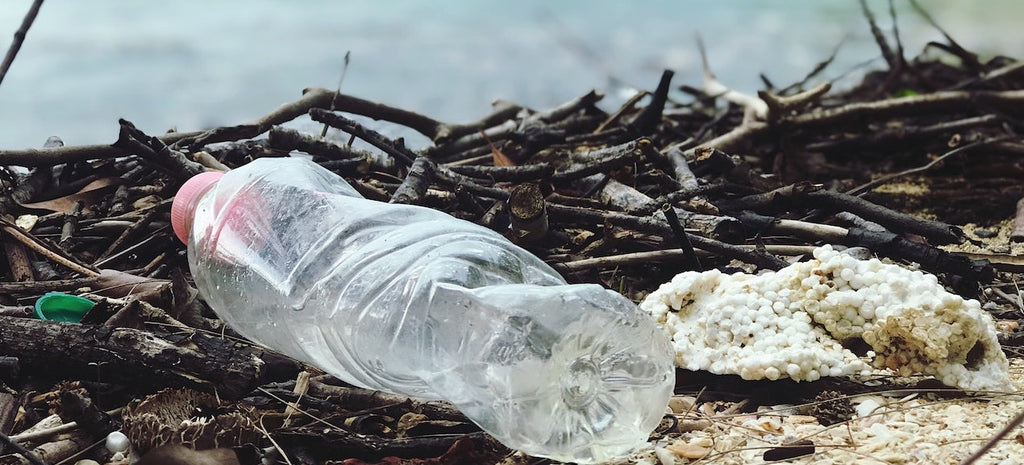Your Cart is Empty
Recycled Nylon Properties: What is it? How is it made?
Recycled nylon is a versatile and eco-friendly material. It has all of the benefits of regular nylon, with one important distinction: it's made from recycled waste.
Recycled nylon is made from old nylon products like fishing nets and carpet fibres, which are melted down and spun into new yarn. Essentially it gives old items destined for landfill a new lease of life.
This recycled material is just as strong and durable as virgin nylon. You can wear it, swim in it, climb in it, all the while feeling good about the planet.
Brands like Pategonia love recycled nylon, and countless other highstreet stores are jumping on the bandwagon.
So what is recycled nylon?

What is recycled nylon?
Recycled nylon is a fabric made from nylon waste products such as fishing nets, carpet fibres, and other discarded nylon textiles.
This makes it different to virgin nylon, which is made from fossil fuels like petrol and crude oil.
Whilst virgin nylon is resource and energy intensive to create, recycled nylon is different. It requires no new fossil fuel based materials to make the fabric. Instead, the used nylon waste products are melted down and woven into yarn.
Not only does this save energy and require no fossil fuels to make the raw material, it saves waste nylon from being landfilled.
So how is recycled nylon made?
To make recycled nylon, nylon waste is first broken down into its chemical components. This waste might include old fishing nets, nylon scraps, carpet fibres, or even offcuts of nylon left over from the manufacturing of clothing.
Once it’s broken down, this pure nylon follows the same manufacturing process as virgin nylon.
It’s heated up until it melts, then it is forced through a spinneret, a showerhead like object which creates long thin fibres. These fibres are then woven into a nylon thread, which can be used to make recycled nylon clothes.

What are the properties of recycled nylon?
Recycled nylon and virgin nylon have the same properties. So what are the properties of recycled nylon?
The properties of recycled nylon are:
- Sustainable: Recycled nylon is environmentally friendly compared to most man made fabrics. In fact, recycled nylon is rated A in the Made-By sustainable rankings. We’ve written more on recycled nylon’s sustainability here.
- Strength: Recycled nylon fabric is strong. This is because the fibres are woven close together, meaning the fabric won’t tear or split easily.
- Durable: The result of this strong fabric, recycled nylon is incredibly durable. This makes it ideal for anything from outdoor gear to rucksacks.
- Lightweight: Nylon fabric is lightweight, again making it great for things like rucksacks or sports gear
- Elastic: recycled nylon is elastic, meaning it will stretch a little but spring back to its original shape.
- Water resistance: due to the tight fibres and smooth texture, water droplets slide off recycled nylon fabric. It also won’t absorb water, making it water resistant.
Is recycled nylon waterproof?
Yes, recycled nylon is waterproof. The fibres that form recycled nylon are packed tight together. As well as this tight structure, the texture of nylon fabric is smooth.
This means that water will slide right off the material rather than soak in and get absorbed.
Water won’t get absorbed into the fibre because it is essentially a plastic. So even when it does get wet or is allowed to sit in water, it will dry very quickly.
This makes recycled nylon perfect for outdoors gear like jackets, bags and fleeces. Recycled nylon is a great water resistant fabric.

Is recycled nylon toxic?
Recycled nylon is generally considered non-toxic and safe to wear. Whilst there is huge amounts of conflicting information about the safety of plastic based materials like nylon, the majority of evidence suggests that it is not going to cause any reactions provided you are not allergic to synthetics.
With this being said, there is always a risk with all fabrics. Cotton for example, is grown using a huge number of herbicides and pesticides which can stay on the fabric. Similarly, during the production of nylon, toxic contaminants could be mixed into the process.
If contaminants did enter the supply chain when nylon is recycled, the quality of the raw material would be lower. As a result, manufacturers are careful to avoid this.
It is still important to remember that nylon is created from various chemicals, and toxins can enter the production process in the form of chemical dyes, bleaches or treatments.
The risk associated with recycled nylon is thought to be much lower, but no man made or treated fabric is without risk. Concerns are much lower compared to food and drinks containers made from plastics.

Is nylon safe to wear?
So the next logical question, is recycled nylon safe to wear? The short answer is yes, recycled nylon is definitely safe to wear.
Nylon is free from endocrine disruptors such as BPA and BPS.
The largest area for concern might lie in the fact recycled nylon can trap heat and prevent moisture from escaping. This can lead to the build up of bacteria on the fabric, which is why man made fibres can start to smell more quickly than some natural fibres.
To help limit this, a natural or organic base layer is recommended. Keeping your clothes clean will also help.
With that being said, the consensus is that recycled nylon is safe to wear. There are always risks when buying any man made fabric, but generally they are small.
Most recycled nylon manufacturers also have more transparent supply chains and are focused on the environment in comparison to regular nylon manufacturers. They therefore have a financial incentive to produce cleaner, higher quality fabrics that are safe to wear.
The risks are small, and the advantages of this strong, durable and sustainable fabrics are clear. I suggest still buying recycled nylon where it’s available, especially as a superior alternative to regular nylon.
Is recycled nylon biodegradable?
Sadly one of the key disadvantages of recycled nylon is that it is not biodegradable.
Recycled nylon is still a plastic fabric, meaning that it won’t biodegrade over time. This means that all recycled nylon that has ever been created is still in existence, either in landfills or in our oceans.
It’s estimated that 640,000 tonnes of abandoned or lost fishing gear ends up in our oceans each year, much of it made from plastic nylon. That’s the equivalent of 50,000 double decker buses!
Microplastics are also a huge problem with plastic based fabrics like nylon. Every wash sheds microplastics which are too small for waste treatment sites to filter them out. As a result, they end up in streams, rivers and eventually our oceans.
That’s why you must always take proper care when washing your nylon or recycled nylon clothes. Use a nylon catching mesh bag.

Why is recycled nylon so expensive?
Recycled nylon is still very expensive, especially when compared to virgin nylon. That is why most companies opt for the easier route and choose virgin nylon rather than recycled nylon.
One of the key reasons recycled nylon is expensive is because it has to undergo a more sophisticated recycling system than most recycled materials.
After the waste products are collected, they have to be thoroughly cleaned. Most recyclables melt at a high temperature, removing all impurities such as plastic or metallic debris. Nylon melts at a relatively low temperature.
Imagine a fishing net that has been dragged around the bottom of the ocean for years. Before this is recycled, it has to be cleaned to remove all dirt and bacteria.
Once this is done, nylon can be shredded down into its pure form, before being pushed through a spinneret and woven into fabric. This process of cleaning and producing recycled nylon thread is expensive.
Another reason is because there is not the demand for recycled nylon. Until demand increases or we increase pressure on companies to be more sustainable, the incentive for brands to use recycled nylon won’t rise which will keep prices higher.
Does recycled nylon stretch?
Recycled nylon is stretchy when woven, which is why it can be used for sports gear. It can also be mixed with other materials to increase the elasticity, such as spandex.
Many recycled nylon products are made using a tightly-knit weave. This creates a very strong, tough fabric that is less stretchy.
Since recycled nylon is chemically identical to regular virgin nylon, it has all the normal fabric attributes.

Does recycled nylon shrink?
Recycled nylon does not easily shrink in the wash or using a tumble dryer. This is because both 100% nylon and recycled nylon fabrics are durable and won’t flex as easily.
Nylon can shrink a little in very hot heat in the dryer, but shrinkage will be minimal. If you are trying to shrink nylon clothes, you would be better hemming them up rather than trying to shrink it.
Recycled nylon blends might shrink more easily. It’s common to see recycled nylon blended with spandex, polyester or cotton. These blends will shrink more easily in high heat in the dryer.
Is recycled nylon synthetic?
Yes, recycled nylon is a synthetic fabric. It’s completely man made, and like virgin nylon is a plastic based material.
Nylon is actually one of the oldest synthetic fabrics, created in the 1930s by the manufacturer DuPont. It wasn’t until after the war that it really started to gain popularity.

Is recycled nylon soft?
Recycled nylon is quite soft, but exceptionally strong and lightweight.
This is why it has been used in many everyday items such as stockings, swimwear or even yoga leggings.
Is recycled nylon breathable?
Recycled nylon is warm, but it is not especially breathable. 100% recycled nylon does not have the ability to wick moisture through the fabric easily, and has almost zero absorbencies.
This means that if you are sweating, 100% recycled nylon can trap moisture. It’s why it is perfect for outer layers, or smaller items like swimwear.
Other properties of recycled nylon include the fact it is lightweight, wrinkle resistant, and dries quickly.
Want to know more?
What are the advantages and disadvantages of nylon?
Is recycled nylon sustainable - 15 eco pros and cons
What are the advantages and disadvantages of recycled polyester
Sustainable fabrics guide - which fabrics are most eco-friendly?
Leave a comment
Comments will be approved before showing up.